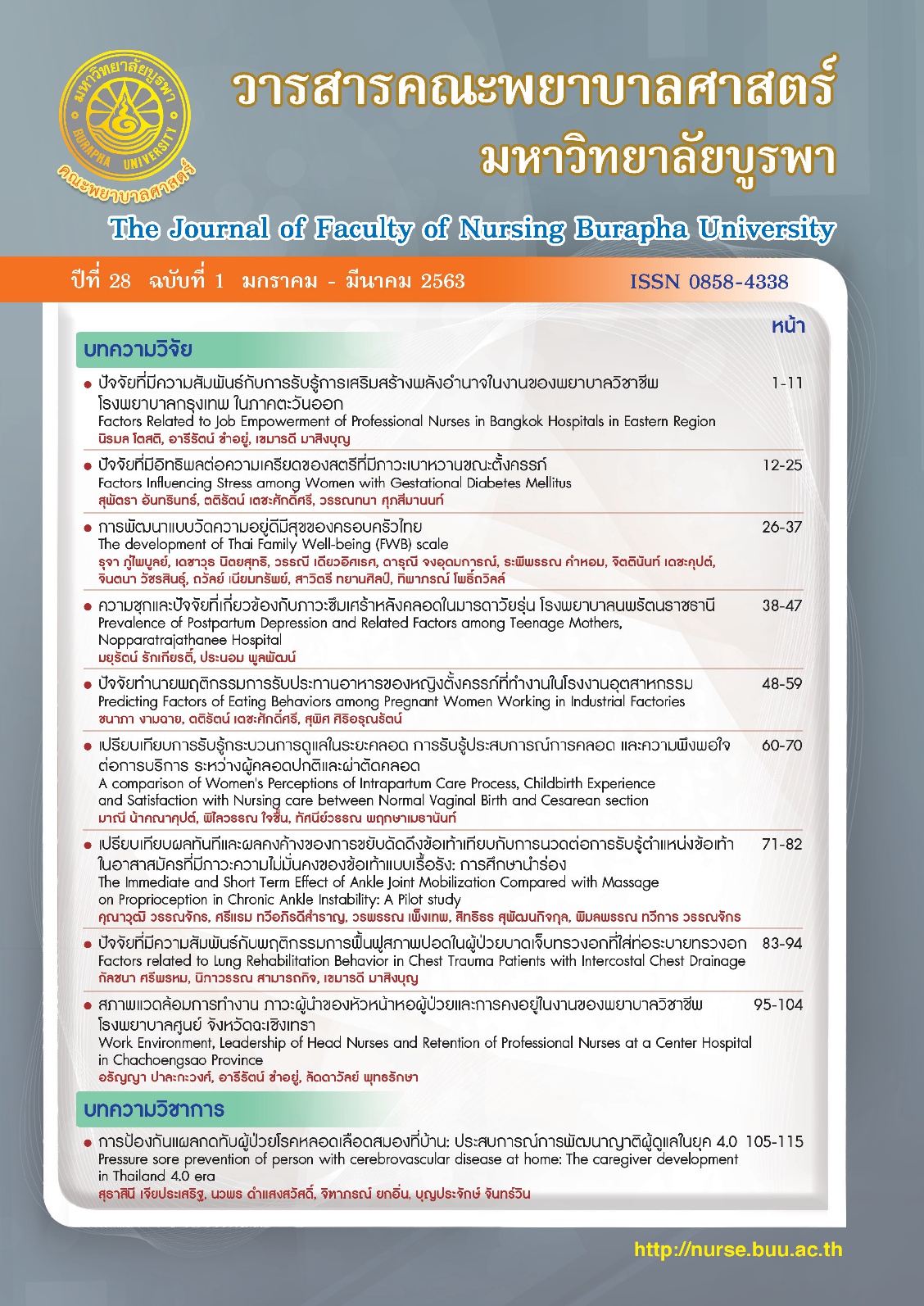การป้องกันแผลกดทับผู้ป่วยโรคหลอดเลือดสมองที่บ้าน: ประสบการณ์การพัฒนาญาติผู้ดูแลในยุค 4.0
คำสำคัญ:
แผลกดทับ, ญาติผู้ดูแล, โรคหลอดเลือดสมองบทคัดย่อ
บทคัดย่อ
การดูแลผู้ป่วยโรคหลอดเลือดสมองที่บ้านซึ่งญาติผู้ดูแลมีบทบาทสำคัญมาก โดยเฉพาะในยุค 4.0 ญาติสามารถนำเทคโนโลยีมาช่วยในการดูแล แผลกดทับเป็นภาวะแทรกซ้อนที่มีโอกาสเกิดขึ้นได้กับผู้ป่วยที่มีข้อจำกัดในการเคลื่อนไหว ซึ่งเมื่อเกิดแผลกดทับแล้วจะส่งผลกระทบต่อทั้งสภาพร่างกาย จิตใจของผู้ป่วยและญาติผู้ดูแล การป้องกันไม่ให้เกิดแผลกดทับจึงเป็นวิธีที่ดีสุด ทั้งนี้ญาติผู้แลจึงจำเป็นต้องมีสมรรถนะ ความสามารถ ความมั่นในใจการดูแล ผู้ป่วยโรคหลอดเลือดสมองเพื่อป้องกันแผลกดทับ ในระบบบริการสุขภาพชุมชนมีการใช้เทคโนโลยีอย่างเหมาะสม เข้ามามีส่วนร่วมการดูแลผู้ป่วยโรคหลอดเลือดสมองในการติดตามเยี่ยมบ้าน บทความฉบับนี้เป็นการทบทวนวรรณกรรมเกี่ยวกับแผลกดทับในผู้ป่วยโรคหลอดเลือดสมอง สมรรถนะญาติผู้ดูแล วิธีการ รูปแบบที่ใช้ในป้องกันแผลกดทับที่บ้าน และประสบการณ์การลงเยี่ยมบ้าน เพื่อนำไปสู่การพัฒนารูปแบบการป้องกันแผลกดทับที่บ้านและทดสอบด้วยกระบวนการวิจัยต่อไป
เอกสารอ้างอิง
Bawornthip, P. & Pienrakkarn, K. (2019). Community nurse roles in using health care technology for patients with hypertension in Thailand 4.0. Journal of Nurses Association of Thailand Northern Office, 25(1), 14-22. [In Thai]
Busayarasamee, B. (2018). Needs of family caregivers of stroke patients for family careteam support in Nakhonpathom municipality. Region 4-5 Medical Journal, 37(2), 192-200. [In Thai]
Chantra, C. (2017). Problems and requirements of primary caregivers in involving nutrition and bed sore prevention of bedridden elderlies. Princess of Naradhiwas University Journal, 3(8), 41-50. [In Thai]
Chawalitsupasearani, P. (2010). Comparison of pressure ulcer risk factor and caregivers, capability on prevention of pressure ulcer development among hospitalized stroke patients. Master of Nursing Science Thesis, Adult Nursing, Prince of Songkla University. [In Thai]
Chiaprasert,S., Sakunhongsophon, S. & Terathongkum, S. (2019). Effects of pressure ulcer prevention program on knowledge and self-efficacy of family caregivers in decreasing pressure ulcer risk of patients with cerebrovascular disease. The Bangkok Medical Journal, 15(1), 51-56.
Chobchuen, R. (2013). Nursing care in pressure sore. Srinagarind Medical Journal, 28(4), 41-46. [In Thai]
Dealey, C., Posnett, J., & Walker, A. (2012). The cost of pressure ulcer in ulcer in United Kingdom. Journal of wound care, 21(6), 261-266. doi: 10.12968/jowc.2012.21.6.261
Dharmasaroja, P. (2012). Ischemic stroke. Bangkok: Jaransanitwong. [In Thai]
Gibson, J. M., Kelly, A.K., & Kaplan, K.A. (2012). Family Caregiving and Transitional Care: A Critical Review. Retrieved April 30, 2018 from https://www.caregiver.org/sites/caregiver.org/files/pdfs/FamCGing_TransCare _CritRvw_FINAL10.31.2012.pdf
Kestsumpun, Y., Tompampon, A., Apiradeewajeeset, N., & Prasangsit, J. (2009). Care for pressure ulcers science and art for nursing. Bangkok: Thai effect studio. [In Thai]
Khamnuan, P., Chuayunan, N. & Deaupakarakul, S. (2018). Efficacy of clinical practice guidelines for prevention pressure injury in risk patients, Phayao hospital. Hua Hin Sook Jai Klai Kangwon Journal, 3(2), 89-101. [In Thai]
Khawanmuang R. (2001). Pressure ulcer risk assessment in patients with limited activity. Master of Nursing Science Thesis, Adult Nursing, Mahidol University.
Laiwarin, W. & Liankruea, K. (2016). Development of care model for cerebrovascular disease patient in Phaholpolpayuhasena hospital. Journal of Nursing Division, 43(3), 92-113. [In Thai]
Nakhornriab, S., Wattanakitkrileart, D., Charoenkitkarn, V., Chotikanuchit, S., & Vanijja, V. (2017). The effectiveness of mobile application on medication adherence in patients with stroke. Journal of Nursing Science, 35(3), 58-69. [In Thai]
Oupra, R., Ruengkhome, C., Wongpalee, J., & Kantawong, E. (2011). Stroke caregivers’ care giving experiences. Rajabhat Journal of Sciences, Humanities & Social Sciences, 12(2), 50-59. [In Thai]
Paoin ,W. (2017). Thailand health 4.0 challenges and opportunities. Journal of the Thai Medical Informatics Association, 1, 31-36. [In Thai]
Sakunhongsopon, S., Anantachok, S. & Honsakun, K. (2011). Selected factors, activities of daily living and complications in stroke Survivors at home. The Journal of Nursing and Education, 4(2), 36-52. [In Thai]
Sirapo-ngam, Y. (2012, 18-20 July). Life of relatives chronic patients. In Wittayasooporn (Chair), Caring for the Family Caregiver. Ramathibodi Academic Conference. Bangkok. [In Thai]
Stephens, M., & Bartley, CA. (2018). Understanding the association between pressure ulcers and sitting in adults what does it mean for me and my carers? Seating guidelines for people, carers and health & social care professionals. Journal of Tissue Viability, 27(1), 59-73.
Suttipong, C.& Sinduh, S. (2011). Factors predicting development of pressure ulcer in non-diabetic elderly stroke patients. Journal of Nursing Science, 29(Suppl 2), 113-123. [In Thai]
Suwannathen, S., Kinboon, N., Tirakoat, S., Hiruncharoenvate, C., & Ssripasuda, L. (2019). State and problem of digital technology usage of elderly in Muang district, Khon khan province. Journal of Graduate School, 16(74), 235-245. [In Thai]
Tamnanthong N., & Kowsuwon W. (1997). The cost of treating pressure ulcers. Srinagarind Medical Journal, 12(2), 74-82. [In Thai]
Timtong, P., Keeratiyutwong, P. & Sulasurn, R. (2011). Factors related to dependent care ability of caregivers in stroke patients. The Journal of Faculty of Nursing Burapha University, 1(16), 9-21. [In Thai]
The National Pressure Ulcer Advisory Panel (NPUAP). NPUAP Pressure injury stages. Retrieved March 22, 2019 from https://www.npuap.org/resources/educational-and-clinical-resources/npuap-pressure-injury-stages/
Whitty, J, A., McImmes, E., Bucknall, T., Webster, J., Gillespie, B. M., Banks, M., et al. (2017). The cost-effectiveness of a patient-centred pressure ulcer prevention care bundle: Findings from the INTACT cluster randomized trial. International Journal of Nursing Studies, 75, 35-42.
Winaiprasert, P. & Mamom, J. (2019). Development the required daily nutrition applications (nutu-app) to promote nutrition status in patients with pressure ulcers. Thai Science and Technology Journal, 27(3), 485-498. [In Thai]
Wonginyoo, A., Prasarnnate, R. & Wongcharee, A. (2019). The study of stress and burden of caregivers of stroke patients, Muang Udon Thani. Nursing, Health, and Education Journal, 2(4), 40-49. [In Thai]





